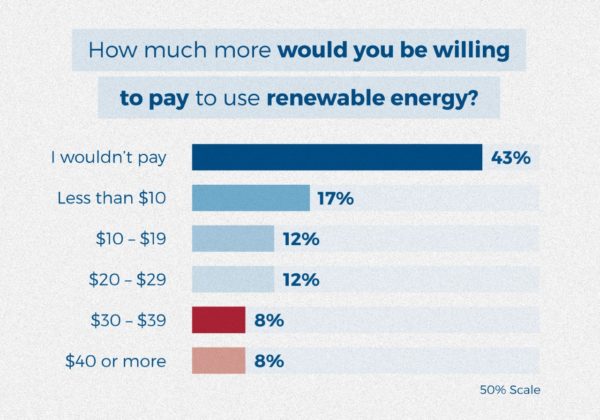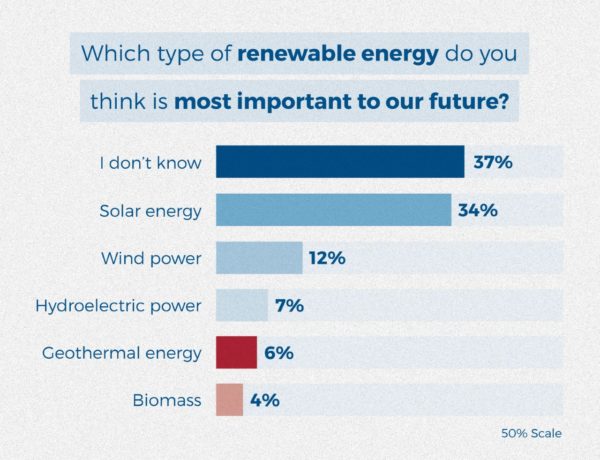In 2010 wind and solar comprised just 1% of the U.S. energy mix. Today, 10 years later, renewable energy supplies more power to America’s grid than coal.
However as renewable energy usage and generation are growing (and despite the fact that Americans want to use it), the results of a recent survey conducted by Siege Media indicates that many still view renewable energy as a “nice to have,” rather than essential for our future.
Almost half (43%) of those surveyed said they would not be willing to pay more on their utility bills to use renewable energy:

Of those that responded, millennials were most likely to be willing to pay more to use renewable energy, while those over 65 years-old were least likely.
In stark contrast, the survey found that those over 65 were more concerned about energy scarcity for future generations than those who it will directly affect (31% vs. 16%).
Which renewable energy source is most important? Most don’t know
Siege also asked Americans which renewable energy source they thought was most important and found that 37% didn’t know:

Enough sunlight hits the earth in 1 hour to power the entire world for a year. Wind power provides energy just as cheaply as fossil fuels, offering another compelling solution.
Further renewable energy growth requires educated voters
Although some researchers have concluded that using 100% renewable energy may not be possible in the U.S., the benefit of increasing our renewable footprint is an important part of reducing carbon emissions:
Renewable energy is the most cost‑effective way of providing 90% of the required reduction in energy‑related carbon dioxide emissions.
– The International Renewable Energy Agency (via The U.N.)
However, to maximize U.S. renewable energy usage and reduce carbon emissions, policy changes must occur. And if the public is unable to make informed decisions regarding who to elect, favorable policy change will be hard to create.
It seems more education on the threat climate change poses and why renewable energy is an important part of combating it is needed. Experts agree.
Methodology
The survey consisted of three questions conducted through Google Surveys run on November 13, 2019. Siege collected 1,000 completed responses per question and added post-stratification weighting to ensure an accurate and reliable representation of the total population.
***
Scott Turner is a content marketing specialist at Siege Media, a content marketing agency. He came to Siege after spending time as a an engineer, travel magazine photographer and marketing head for a niche executive sales recruiting firm.
The views and opinions expressed in this article are the author’s own, and do not necessarily reflect those held by pv magazine.
This content is protected by copyright and may not be reused. If you want to cooperate with us and would like to reuse some of our content, please contact: editors@pv-magazine.com.







“In 2010 wind and solar comprised just 1% of the U.S. energy mix. Today, 10 years later, renewable energy supplies more power to America’s grid than coal.”
It was about this time that the electric utilities realized that independent residential solar PV was a threat to their operations on more than one level. Back just in 2005 the electric utility was laughing at the homeowner who put in a solar PV system, will never pay for itself, we do it so much cheaper that there will be no payback on the system. Those who have used the technology realized pretty quickly that the money saved over the year can be used to pay homeowners insurance, taxes, buy food or some other daily need, ‘other’ than electricity. Money in the bank at a lousy and often insulting 0.5% to 1.5% APY does less than putting the money on one’s roof in solar PV and decreasing or eliminating a monthly electric bill for life. Now adopters are realizing that smart ESS should be part of the system. Solar PV with ESS allows one to shift solar PV generation and increase the non-fueled generation to use after the sun goes down.
What interests me the most about this survey is the discrepancy between concern for our energy future and willingness to do something about it. Millennials, apparently, are optimistic about humanity’s abilities to solve its problems and are willing to act to make it happen. What can be done to help the fatalists join the cause?